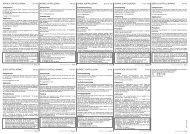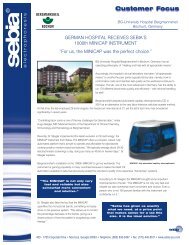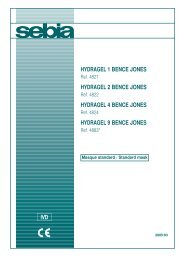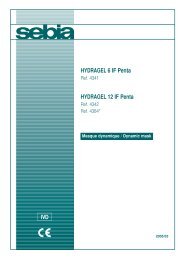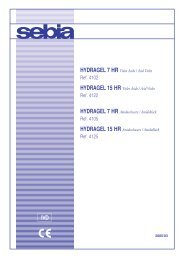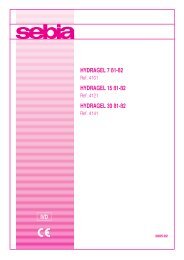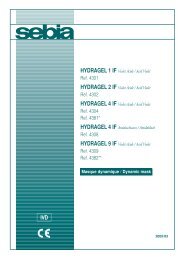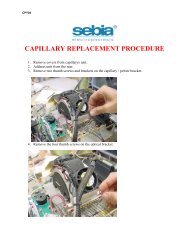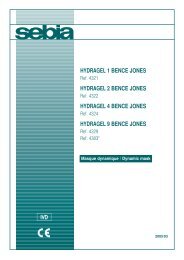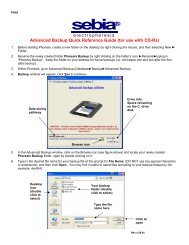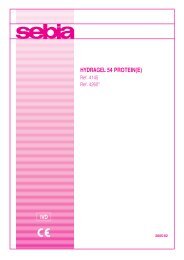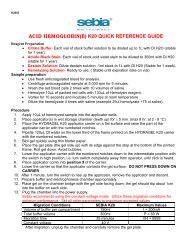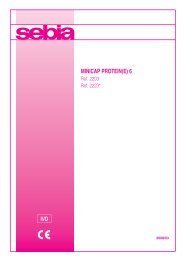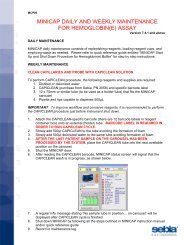CAPILLARYS HEMOGLOBIN(E)
CAPILLARYS HEMOGLOBIN(E) - Sebia Electrophoresis
CAPILLARYS HEMOGLOBIN(E) - Sebia Electrophoresis
- No tags were found...
Create successful ePaper yourself
Turn your PDF publications into a flip-book with our unique Google optimized e-Paper software.
<strong>CAPILLARYS</strong> <strong>HEMOGLOBIN</strong>(E) - 2010/10<br />
EQUIPMENT AND ACCESSORIES REQUIRED<br />
1. <strong>CAPILLARYS</strong> 2 FLEX PIERCING System SEBIA, PN 1227.<br />
2. Sample racks supplied with <strong>CAPILLARYS</strong> 2 FLEX PIERCING.<br />
3. Container Kit supplied with <strong>CAPILLARYS</strong> 2 FLEX PIERCING: Rinse (to fill with distilled or deionized water), wash solution and waste container.<br />
4. Collection tubes with 75 mm length and 13 mm diameter with corresponding caps (maximal length of tube with cap : 82 mm, maximal diameter of<br />
cap : 17 mm) : BD Vacutainer 13 x 75 mm, Terumo Venosafe 5 mL, Greiner Bio-one Vacuette 1, 2, 3 or 4 mL 13 x 75 mm or collection tubes with<br />
equivalent dimensions approved for clinical assays.<br />
5. Tubes and caps for Controls, SEBIA, PN 9202 : 20 conical tubes and their caps to analyze blood controls with the <strong>CAPILLARYS</strong> 2 FLEX<br />
PIERCING system.<br />
6. Wedge adapters for tubes for controls (yellow) SEBIA, PN 9203, 10 units (or supplied with <strong>CAPILLARYS</strong> 2 FLEX PIERCING).<br />
SAMPLES FOR ANALYSIS<br />
Sample collection and storage<br />
Fresh anticoagulated whole blood samples collected in tubes containing EDTA as anticoagulant are recommended for analysis. Avoid anticoagulants<br />
containing iodoacetate. Blood must be collected according to established procedures used in clinical laboratory testing.<br />
Samples may be stored for up to 7 days between 2 and 8 °C.<br />
NOTE: Samples should not be stored at room temperature! Do not store them at – 80 °C without any preparation.<br />
Progressive hemoglobins (Hb) degradation may occur for samples stored between 2 to 8 °C.<br />
When the blood sample is stored for more than 7 days at 2 – 8 °C:<br />
• a weak fraction, corresponding to methemoglobin, appears in the Hb S migration zone,<br />
• when Hb C is present, a fraction corresponding to degraded Hb C appears more anodic than Hb A2 which does not interfere with it (Z4 zone, see<br />
the table in paragraph "Interpretation"),<br />
• when Hb O-Arab is present, a fraction corresponding to degraded Hb O-Arab appears in the Hb S migration zone (Z5 zone, see the table in<br />
paragraph "Interpretation"),<br />
• when Hb E is present, a fraction corresponding to degraded Hb E appears in the Z6 zone (see the table in paragraph "Interpretation"),<br />
• when Hb S is present, a fraction corresponding to degraded Hb S appears in the Hb F migration zone (Z7 zone, see the table in paragraph<br />
"Interpretation"),<br />
• when Hb A is present, a fraction corresponding to degraded Hb A ("aging fraction" of Hb A) appears more anodic (Z11 zone, see the table in<br />
paragraph "Interpretation").<br />
When Hb F is present (in blood samples from newborn babies), a fraction appears in the Hb A migration zone (Z9 zone, see the table in paragraph<br />
"Interpretation") due to the sample degradation.<br />
When stored for more than 10 days, viscous aggregates in red blood cells are observed ; it is necessary to discard them before the analysis.<br />
For longer storage, samples can be frozen at – 80 °C within 8 hours of collection after having washed the red blood cells according to the following<br />
procedure: Centrifuge anticoagulated blood at 5 000 rpm for 5 minutes ; discard the plasma ; wash the red blood cells (RBC) 2 times with 10 volumes<br />
of saline (centrifuge after each washing step) ; discard the excess of saline over the red blood cells pellet and vortex them before freezing.<br />
Frozen blood samples are stable for 3 months maximum at - 80 °C.<br />
IMPORTANT: For optimal storage of blood samples, store them at – 80 °C. Do not store at – 20 °C (see BIBLIOGRAPHY, J. Bardakdjian-Michau et<br />
al, 2003).<br />
Sample preparation<br />
• Use directly whole blood samples.<br />
• Check that all the tubes contain 1 mL minimum of blood and are perfectly closed.<br />
• Vortex for 5 seconds blood samples stored at 2 – 8 °C for one week.<br />
WARNING: The tubes must be closed with their corresponding caps designed for the <strong>CAPILLARYS</strong> <strong>HEMOGLOBIN</strong>(E) procedure with the<br />
<strong>CAPILLARYS</strong> 2 FLEX PIERCING system (see EQUIPMENT AND ACCESSORIES REQUIRED).<br />
Particular cases:<br />
Analysis of samples without any Hb A or Hb A2 (these samples are perfectly quantified but not identified by zones):<br />
To identify hemoglobin fractions in a sample without any hemoglobin A or hemoglobin A2, it is recommended to prepare this sample according to the<br />
following procedure :<br />
- Vortex for 5 seconds the whole blood sample.<br />
- In a conical tube for control, mix one volume (50 µL) of whole blood to analyze with one volume (50 µL) of Normal Hb A2 Control and cap the tube.<br />
- Vortex for 5 seconds.<br />
- Place the tube with a wedge adapter on a sample rack of the <strong>CAPILLARYS</strong> 2 FLEX PIERCING system.<br />
- Slide the sample rack into the <strong>CAPILLARYS</strong> 2 FLEX PIERCING system.<br />
- Perform the analysis of this sample according to the standard procedure like a usual blood sample.<br />
The results are then automatically considered by the software for the data analysis.<br />
IMPORTANT: For a sample without any Hb A or Hb A2 prepared according to this procedure, the result obtained with the mixed sample will enable<br />
presumptive variant identification due to the positioning of the hemoglobins fractions in the appropriate identification zones. Do not report the relative<br />
quantification from the mixed sample result.<br />
The relative quantification of hemoglobins should be reported utilizing the initial, unmixed sample result (without any dilution in the blood control).<br />
- 47 -



